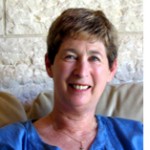By Dorothea Shefer Vanson

MEVASSERET ZION, Israel — A few years ago I was asked to prepare the text for a website for Joseph Hirsch (1920-1997), a highly regarded Israeli artist who also happened to be my mother’s first cousin (double first cousin, actually, as two brothers had married two sisters in pre-WW1 Germany, one of those couples eventually becoming my grandparents).
Joseph was always called ‘Boujik’ in the family, apparently because a childhood nursemaid had been enchanted by his sweet appearance and nature. When I knew him he was a tall, angular man with the typical ironic sense of humor that I associate with ‘Yekkes,’ and those of my family in particular.
I collected material from various sources, catalogues from his exhibitions, reviews by art critics, as well as recollections by former students and prepared a text that I thought was suitable, but unfortunately the website never came into being. Now the Israel Museum is preparing a project of its own, giving leading Israeli artists a place in Wikipaedia, and I was happy to hear that Hirsch, as his students called him, was to be included in it.
Artist, philosopher, and teacher—Joseph Hirsch was all of these, according to art critics. His paintings express many aspects of his complex worldview, but above all they convey his ability to tease out the essence of the material world around him—as embodied in both people and objects—in order to express its innermost poetry and deeper, metaphysical significance. Many of Hirsch’s pictures convey his own idiosyncratic interpretation of the material universe and the individual’s relation to it.
Several works by Joseph Hirsch, one ofIsrael’s foremost artists, have been purchased by leading museums, including theBritishMuseumand theIsraelMuseum. Gifted both as a teacher and as a painter, upon his death he left a legacy of hundreds of devoted and admiring pupils.
Hirsch’s paintings, the vast majority of which are monochrome compositions on paper, reveal a world outside and beyond the ordinary, humdrum one inhabited by mankind. A consummate draftsman, Hirsch contrived to imbue the outer form of objects and people with their innermost essence. This applied as much to everyday objects, such as a vase of flowers, a rug, or a doll in his still lifes, as to the various models who posed for him.
Joseph Hirsch was born in 1920 in the mining town ofBeuthen,Silesia, then part ofGermany, to an orthodox Jewish family. His interest in painting and drawing was evident from early childhood, and his parents helped and encouraged him in cultivating this talent. He was thirteen years old when Hitler came to power in 1933, and the anti-Jewish atmosphere, with the restrictions imposed by the Nuremberg Laws, overshadowed his teenage years.
Hirsch immigrated to what was thenPalestinein 1939, and attended the Bezalel Academy of Art and Design in Jerusalem. The artist Hermann Struck, one of the founders of Bezalel, was sufficiently impressed with Hirsch’s promise to secure him a Certificate, the precious document which entitled the recipient to immigrate toPalestine, then under the British Mandate. After working as a sign-painter for the British authorities and later in newly-nascent Israel, Hirsch was invited to join the staff of the Bezalel Academy in 1964, continuing to teach there until his death.
Even in his final, mortal illness Boujik retained his characteristic dry sense of humor. A former student who visited him in hospital recounts that he commented to the nurse who entered his room, “I can see by your sadistic smile that you’ve come to give me my morning injection,” occasioning hearty laughter on her part.
Boujik died in Jerusalem in November 1997, aged 77.
*
Dorothea Shefer-Vanson is a freelance writer and translator who lives in the Jerusalem suburb of Mevasseret Zion. She may be contacted at dorothea.shefer@sdjewishworld.com This article initially appeared in the AJR Journal, published by the Association of Jewish Refugees. You can read more on her blog: http://fromdorothea.wordpress.com